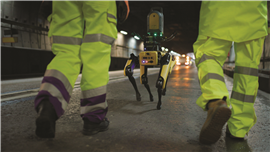How Mace is harnessing data to become more efficient
03 August 2023
Catrin Jones speaks to Stephen Jeffery about Mace’s tech-driven approach to efficient construction.
Everyone in the industry is wrestling with the same issue – how can we be more efficient and productive?
Stephen Jeffery, chief technical officer (CTO) at Mace, is tasked with providing solutions to that very question and he believes that technology has a big part to play.
“We’re sure we’re not alone constantly wrestling with efficiency and productivity,” says Jeffery. “We are constantly looking to see how we can make our teams more efficient as well as our trade and our subcontractors.”
 Stephen Jeffery, Chief Technical Officer (CTO) at Mace (Photo: Mace)
Stephen Jeffery, Chief Technical Officer (CTO) at Mace (Photo: Mace)
Jeffery has been the CTO at global consultancy and construction firm Mace since 2019.
Operating around the world, Mace has numerous projects ongoing at any given time and the company believe that technology has a role to play in simplifying the process of managing them all.
For Mace, augmented reality (AR) and virtual reality (VR) technologies are already a part of the company’s fabric. “I wouldn’t say it was embedded in every one of our jobs, but we have been using the technology for the last three or four years. We do not necessarily see that as an emerging technology; we think that it is here and now.”
Collecting data in construction
Data collection plays a crucial role in the construction industry, enabling companies to gather and analyse information to improve project management, productivity, and decision-making.
Jeffery notes that Mace is very rich in data, but that the company’s next step is learning how to use it more efficiently.
To effectively collect and utilise construction data, it is important to establish appropriate data management systems.
Jeffrey says that collecting and maintaining good digital records has been a practice at Mace for several years.
“I think that we are ahead of the curve,” says Jeffery. “We’ve spent a few years introducing a data hub at Mace. This is an attempt to drive standardised inputs of what our data looks like across our projects and delivery.
“We look after our projects for a number of years for warranty but, after we move out, obviously a lot happens to a building – people modify stuff. Having the initial records that the right product was installed in the right place is paramount to us.”
Jeffery adds that digital records allow those working on projects to understand the process from start to finish. “You can take a drawing and it will say what product was used and who actually installed it. In addition to this, there’d be photographic evidence as well.”
He also mentions that there is no limit to what Mace keeps digital records for. “We’re doing what we think is right. I think in the future it’s just going to be standard, consistently something that we do; it’ll just be business as usual.”
By doing so, Jeffrey believes this will allow the company’s teams more time to concentrate on different things.
‘Spot the dog’
Mace and Heathrow Airport partnered at the end of last year in a bid to improve efficiency and safety on major construction projects. The team trialled ‘Spot the Dog’, a robot developed by Boston Dynamics, equipped with a Trimble X7 scanner to provide 3D laser scans during the ongoing refurbishment of a 1960’s cargo tunnel at Heathrow Airport, UK.
Mace was responsible for leading the refurbishment and the updating of ageing mechanical and electrical services, bringing them into compliance with new regulations.
Jeffery says that the use of robotics in projects has helped to free up a massive amount of resources. “Using the laser scanning technology, whether it’s on a robotic dog or another piece of apparatus, is a game- changer,” he comments.
“The camera technology allows us to see remotely from a computer screen here and the team have then got real-life data to say that everything has been installed correctly.”
 Spot the Dog was recently used on a project at Heathrow Airport (Photo: Boston Dynamics)
Spot the Dog was recently used on a project at Heathrow Airport (Photo: Boston Dynamics)
Beyond data and robotics, those in construction are cautiously watching which other technological advancements can give them greater project efficiency and productivity.
The CTO is placing his bet on artificial intelligence (AI) – he says that it has the potential to change the way in which the industry works.
“AI is going to supercharge things where it can understand what’s happening already. Having that data will help us drive productivity improvements,” he predicts.
But Jeffery doesn’t think the construction industry as a whole is ready for AI just yet.
This is largely because not everyone is recording all the relevant information digitally to make AI useful. As things stand, many in the industry are leaving gaps and ultimately means their data will be invisible to machine learning.
That’s not the situation at Mace but it could be some time before the rest of the sector catches up.
He adds, “Whereas I think organisations like ours, which are taking, certainly for our sector, a very progressive view of data management, data and maintenance are going to be in a really advantageous position when the AI technology emerges and develops to a stage where it can be used at industrial capacity.
“This will transform things massively.”
STAY CONNECTED



Receive the information you need when you need it through our world-leading magazines, newsletters and daily briefings.
CONNECT WITH THE TEAM








